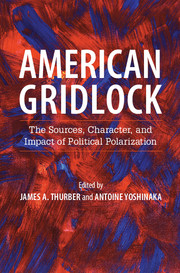Book contents
- Frontmatter
- Dedication
- Contents
- List of contributors
- Foreword
- Acknowledgments
- Introduction
- PART I POLARIZATION AMONG VOTERS AND ACTIVISTS
- PART II POLARIZATION IN NATIONAL INSTITUTIONS
- PART III POLARIZATION IN THE STATES
- 9 Polarization in American State Legislatures
- 10 The Costs of Party Reform: Two States’ Experiences
- 11 The Policy Consequences of Party Polarization: Evidence from the American States
- PART IV POLARIZATION IN THE MEDIA
- PART V IMPLICATIONS AND CONCLUSIONS
- Index
- References
11 - The Policy Consequences of Party Polarization: Evidence from the American States
from PART III - POLARIZATION IN THE STATES
Published online by Cambridge University Press: 05 November 2015
- Frontmatter
- Dedication
- Contents
- List of contributors
- Foreword
- Acknowledgments
- Introduction
- PART I POLARIZATION AMONG VOTERS AND ACTIVISTS
- PART II POLARIZATION IN NATIONAL INSTITUTIONS
- PART III POLARIZATION IN THE STATES
- 9 Polarization in American State Legislatures
- 10 The Costs of Party Reform: Two States’ Experiences
- 11 The Policy Consequences of Party Polarization: Evidence from the American States
- PART IV POLARIZATION IN THE MEDIA
- PART V IMPLICATIONS AND CONCLUSIONS
- Index
- References
Summary
This chapter explores the policy consequences of polarization – asking whether we see different policy choices when parties are more (versus less) polarized. This analysis is motivated by recent research suggesting a constraining effect of partisan polarization on redistributive policy – and contradicting earlier expectations that greater benefits will accrue to the poor when parties are competitive and offer clear policy choices. To better understand these consequences, we capitalized on variation in both policy choices and party polarization over time and across the 50 American states.
• Across eight distinct forms of policy redistribution, we found that party polarization tended to result in lower levels of redistributive policy.
• This was most pronounced for redistributive policies that are not indexed to inflation (so without new legislation, the real value of the policy decreases over time). These policies, such as the minimum wage, are particularly impacted by polarization-induced gridlock.
• For redistributive policies that do increase in magnitude as inflation, incomes, or earnings rise, such as the corporate tax rate, polarization had more of an indirect effect – shifting the impact of party control of the state government.
• These distinct paths of influence for different types of policies illustrate both the importance of polarization for policymaking and the complexity of these relationships.
In recent decades, political parties in the United States have become more ideologically distinct (Rohde 1991; Aldrich 1995; Fiorina 1996; Poole and Rosenthal 1997). During the same time period, we have seen a parallel increase in income inequality (McCarty, Poole, and Rosenthal 2006), as well as the transformation of social welfare policy away from entitlements and cash assistance toward a work- and market-focused system of neoliberal reform (Pierson 2001; Korpi and Palme 2003; Hacker 2004; Schram, Fording, and Soss 2008; Allard 2009). Accounts of these political developments often draw linkages between these trends – describing how party polarization contributes to gridlock and policy drift that tends to disadvantage those with less power and organization (Hacker and Pierson 2010).
The most explicit examination of a relationship between party polarization and policy outcomes is found in McCarty (2007) and McCarty, Poole, and Rosenthal (2006), who describe a “dance of inequality” in which the upward trend in party polarization tracks alongside the declining real value of the minimum wage, as well as regressive shifts in estate and income tax policies.
- Type
- Chapter
- Information
- American GridlockThe Sources, Character, and Impact of Political Polarization, pp. 236 - 256Publisher: Cambridge University PressPrint publication year: 2015
References
- 1
- Cited by



